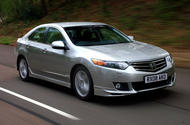A slightly forgettable drive and mixed ergonomics, but a very comfortable and cheap used buy
The Honda Accord has a fine pedigree, a fact that surely attracted people to this eighth-generation model launched in 2008.For example, there was the sharply styled third-generation Accord Aerodeck of the mid-1980s, the swoopy sixth-generation Coupé and much-admired Type R of the late 1990s – and throughout, a succession of handsome estates.So when folk turned up at Honda showrooms for the new Accord’s launch night, they were expecting big things, especially since the outgoing model, launched five years before, had been so successful.In fact, the new model appeared to be just an evolution of the old, albeit slightly larger and fussier-looking. There was the same choice of saloon and estate bodystyles, while the engines – a selection of 2.0 and 2.4-litre petrols and a 2.2-litre diesel, all with four cylinders and in a variety of power outputs – were updated versions of those previously offered. (In fairness, the diesel was comprehensively reworked.)But appearances can be deceptive. Underneath it all, the eighth-generation Accord was all new. Those visitors to the showroom had only to peer at the new dashboard to see that, and those with a technical bent would have noted that the model had gained weight and that the Tourer now shared the same wheelbase as the saloon, which is why the load area had shrunk a bit.The saloon’s boot was smaller too, a consequence of the new, bulkier, multi-link rear suspension. After the launch sparkle had faded, it was apparent the new Accord was caught between a rock and a hard place – the cheaper but no less impressive Ford Mondeo below and the classier and more characterful Mercedes C-Class and BMW 3 Series above.It means that, today, the classifieds aren’t entirely drowning under second-hand examples. Saloons comfortably outnumber Tourers, making the latter more valuable, and there are slightly more diesels than petrols, which is unsurprising given the model’s appeal to company car drivers.Staying with the engines, the rare 198bhp 2.4 i-VTEC petrol is out of its depth – noisy and hobbled by its standard-fit, five-speed automatic gearbox. Meanwhile, the 154bhp 2.0 i-VTEC is sluggish and needs revving hard on gradients.That leaves the two 2.2 i-DTEC diesels. The 148bhp 2.2 is smooth and quiet but a tad pedestrian. The more powerful 177bhp is a better choice but is even rarer than the 2.4i petrol, although it’s worth seeking out for its 280lb ft of torque. The six-speed manual gearbox, available on all models apart from the 2.4i, is light and precise.The Accord was facelifted in 2011, when it gained a restyled nose and tail and new lights. The interior had a slight makeover too, but the ergonomic car crash that is the dashboard remained unchanged. There’s not much leg room in the back, but otherwise the cabin is a nice place to be.Plenty of trims were offered, but today ES (most creature comforts) and EX GT (powered sports seats, sunroof) are the most plentiful. Under way, the Accord’s handling is secure, motorway ride comfort is excellent and it’s quiet and refined.Crucially, the model is also more reliable than most, and when it comes to buying an older used car, unless you’re a speed freak, that’s about the only quality that matters.Honda Accord 2008-2015 common problemsEngine: Manual diesels can suffer premature clutch slip, so boot it from second and see how it likes it. Diesel autos have a low, 1200kg towing limit, making them unsuitable for most caravan-towing duties.Still with diesels, if the car has done abnormally low mileage, take it for an extended test drive checking for running issues, perhaps caused by a clogged diesel particulate filter (DPF). This is potentially very serious because cleaning the DPF can confuse the ECU, which then triggers the warning light again.A new DPF is around £1500. Check for white smoke, possibly caused by a failed head gasket, and examine the exhaust gas recirculation pipe for cracks. Regarding petrol engines, feel for hesitancy as you accelerate, an issue that can be caused by VTEC control problems. Valve clearances should be checked every 30,000 miles.Gearbox: A rattle when pulling away or a series of loud clunks could be the dual mass flywheel breaking up. (Alternatively, the rattle could be the air-con pulley breaking up, to which they are prone.) Suspension and steering: The sophisticated suspension makes for secure handling but it is complex. Still, a fresh MOT should pick up any issues with the upper and lower ball joints at the front, and joints and bushes at the rear. Steering rack motors have been known to fail. (The car may pull to one side.)Brakes: Check the fluid has been changed every couple of years.Interior: Some owners have reported that the windscreen wipers fail to operate on.







